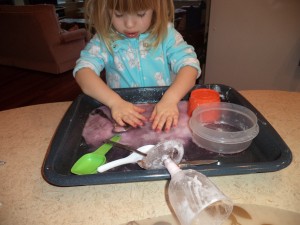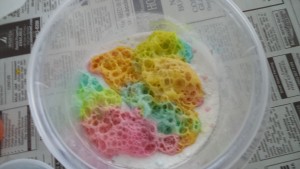Bubble, Bubble, Fizz, and Pop
Soap and water aren’t the only ingredients for bubbles. Another way is baking soda and vinegar science fun. Just a bit of makes lots of fun and learning.
 Scoop some baking soda into a small bowl, fairly flat container, or even a clear plastic wine glass. Set this in another pan to catch the drips. Pour some vinegar into a second dish. Kids can use a spoon or an eyedropper to put a little vinegar onto the soda. They love to do this over and over again and watch as bubbles form and pop, getting high enough sometimes to spill over the edges. The bubbles hiss and pop adding exciting sound effects.
Scoop some baking soda into a small bowl, fairly flat container, or even a clear plastic wine glass. Set this in another pan to catch the drips. Pour some vinegar into a second dish. Kids can use a spoon or an eyedropper to put a little vinegar onto the soda. They love to do this over and over again and watch as bubbles form and pop, getting high enough sometimes to spill over the edges. The bubbles hiss and pop adding exciting sound effects.
Soap bubbles shimmer with color. To a few containers of vinegar, add several drops of food coloring, one color for each bowl. Before squirting on the vinegar, ask kids what they think might happen. Will the bubbles be different colors? What will happen after the bubbles pop? Kids can then try adding the colored vinegar to the baking soda. The colors left behind seem quite vivid, depending on how many drops were in the vinegar.
Like blowing bubbles, this is a fun activity for kids of any age. There are some new words like fizz, hiss, and reaction. While young children are satisfied with the results, older kids might ask questions. Why did it do that? Where did the bubbles come from? Will it always do this? Kids are natural scientists. The explore and ask questions. All. The. Time.
Besides new words, questions, and explanations, there is also a sensory aspect. The soda feels very slippery on hands and fingers. The noises are very soft but exciting just the same and visually, the bubbles are fast and active. Vinegar has a bit of a smell, not particularly pleasant. The mixture isn’t at all tasty so if kids try it once is usually enough.
Is this variation of a bubble activity, baking soda and vinegar science fun, something your child has tried?

